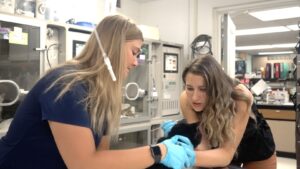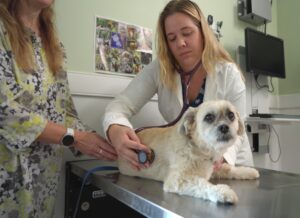By: Quakertown Veterinary Clinic
Not until you yourself are challenged with a sick pet do you fully understand the feelings, the emotions of the person across the table from you with their sick or failing four-legged family member. Now, I was on the other side of the table.

My vocation requires some degree of intelligence, a kind heart, willingness to give and receive hugs and spend quality time with families as we together make kind and correct and necessary decisions concerning quality of life for their pets. Based on love, totally unselfish.
June 6, 2015, I was scheduled to be at Quakertown Veterinary Clinic. For several days before this, Andy (as in Little Orphan), our 12-year-old rescue cat, was progressively less active and going downhill, gradually, then suddenly, seemingly in a free-fall mode. Looking back, it was easy to see those subtle changes that were either missed or dismissed at the time: lack of interest in a toy, unable to jump up on a chair, etc., etc. We were on the other side of the table.
Dr. Sandy Orben identified Andy’s precarious situation as ketoacidosis secondary to diabetes. Oh, the wonders of quick diagnostic work by a competent, caring staff who obtained his multiple blood and urine samples! Anna, a board-certified veterinary technician, said, “I put in his I/V catheter without any help at all” … A combination of a confident caregiver and a good patient who was quite ill.
Andy was hospitalized for three days on a constant intravenous drip and subjected to multiple blood tests and evaluations on his discharge. He was improving but nowhere near the Andy of old. His post-hospitalization instructions included two-a-day injections of glargine [insulin] to begin his lifetime glucose control and a radical change in his diet, the latter being much more difficult than the former.
The use of glargine along with a no carbohydrate diet increases the chance of diabetic remission. But his favorite — dry food — was replaced by canned food. Sounds simple, but wasn’t (isn’t).
Expectations, expectations. We were following all instructions dutifully, including checking his blood sugar at home with a lancet and glucometer — same as used in people — but Andy’s recovery was only plodding along … at least in our minds … for about 10 days.
On the night of June 20 for the first time since he became ill, Andy followed us upstairs and with his “motor running,” did what he has done for the past two years. As I lay in bed pondering life’s important decisions — do I wear a tie tomorrow, who’s pitching for the Phillies, do I cook on the grill tonight? — before I picked up my “fall to sleep” book, he climbed up on my chest a foot from my chin, tucked under his paws and stared at me with purrs, seemingly saying, “I’m Andy again.”
As he stared into my eyes, who had more comfort? The healing feline or the veterinarian who had been on the other side of the table?
I continue to learn, almost daily, the invaluable networking within our families that these beautiful creatures provide — even after greater than five decades of practice.



